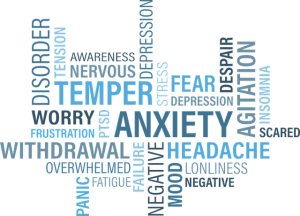Mood Disorders
What are mood disorders?
The term mood disorder broadly applies to a category of psychological states in which emotions are inconsistent with ones experiences and prohibit or inhibit one’s normal functions. Examples of mood disorders, include, but are not limited to:- Major depressive disorder – prolonged, persistent, and extreme sadness
- Bipolar disorder – alternating states of mania and depression (highs and lows)
- Seasonal affective disorder (SAD) – depression as a result of seasonal change, usually from lack of daylight, and the shortening of days in late fall
- Cyclothymic disorder – experiences of highs and lows/ups and downs, similar to, but less sever than, bipolar disorder
- Premenstrual dysphoric disorder – mood changes as a result of the premenstrual phase that typically dissipate with the onset of menstruation
- Persistent depressive disorder (dysthymia) – long term, and chronic form of depression
- Disruptive mood dysregulation disorder – chronic, severe, and persistent irritability. Most common in children, and result sin outbursts and behavior misaligned with the child’s age
What are the symptoms of mood disorders?
Symptoms of mood disorder vary greatly depending on the specific type of disorder. The most common characteristic, however, is that a diagnosable disorder is one which impairs one’s daily ability to function. It is specifically recommended to seek medical assistance if your emotions interfere with work, relationships, or social functions, you struggle with drinking or drugs, or have suicidal thoughts.What causes mood disorders?
The causes of a mood disorder depend on the classification of the disorder. Causes may be biological, psychological, or some combination of the two. Family history and genetics, as well as environmental factors can also play a role in causing mood disorder.How are mood disorders diagnosed?
The defining characteristic in diagnosing mood disorders is the way in which the disorder prevents an individual from functioning. Each disorder has its own specific criteria, but an inability to cope with emotions as they arise, or the degree to which emotions make normal functioning difficult/impossible will determine the necessity of diagnosis and treatment.What are the treatments for mood disorders?
Treatment for mood disorders are dependent on the category of disorder. Various forms of therapy, the development of effective coping strategies, and prescription drugs may be useful in treating mood disorder. Mood disorders rarely get better on their own.Where can I find out more about mood disorders?
- General mood disorders: Mayo Clinic
- Specific mood disorders: NIH
Mood Disorders Articles




First Cohort Dosed in 5-MeO-DMT Trial for Treatment-Resistant Depression
Jessica Lynn
October 26, 2021
Read More »

Dallas Heart Study Finds Link Between Inflammation and Depression
Jessica Lynn
December 18, 2020
Read More »


Family Psychiatric History Linked to Bipolar Disorder Severity
Jessica Lynn
June 25, 2020
Read More »





